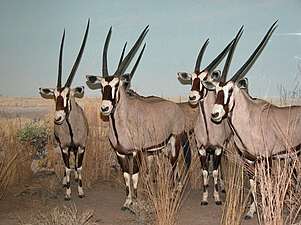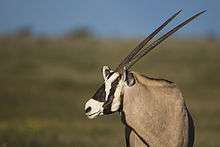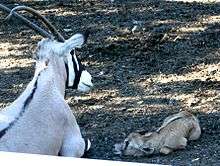Gemsbok
The gemsbok, gemsbuck or South African oryx (Oryx gazella) is a large antelope in the genus Oryx. It is native to the arid regions of Southern Africa, such as the Kalahari Desert. Some authorities formerly included the East African oryx as a subspecies.
| Gemsbok | |
|---|---|
_male.jpg) | |
| Male, Etosha National Park, Namibia | |
| Scientific classification | |
| Kingdom: | Animalia |
| Phylum: | Chordata |
| Class: | Mammalia |
| Order: | Artiodactyla |
| Family: | Bovidae |
| Subfamily: | Hippotraginae |
| Genus: | Oryx |
| Species: | O. gazella |
| Binomial name | |
| Oryx gazella | |
 | |
| Gemsbok's natural range.[2] | |
| Synonyms | |
|
Capra gazella Linnaeus, 1758 | |
The gemsbok is depicted on the coat of arms of Namibia,[3] where the current population of the species is estimated at 373,000 individuals.[1]
Name
The name "gemsbok" in English is derived from Afrikaans gemsbok, which itself is derived from Dutch name of the male chamois, gemsbok,[4] and further from German Gämse ("chamois").[5] Although some superficial similarities in appearance (especially in the facial pattern) are noticed, the chamois and the oryx are not closely related. The usual pronunciation in English is /ˈɡɛmzbɒk/.[6]
Description

Gemsbok are light brownish-grey to tan in colour, with lighter patches toward the bottom rear of the rump. Their tails are long and black in colour. A blackish stripe extends from the chin down the lower edge of the neck, through the juncture of the shoulder and leg along the lower flank of each side to the blackish section of the rear leg. They have muscular necks and shoulders, and their legs have white 'socks' with a black patch on the front of both the front legs, and both genders have long, straight horns. Comparably, the East African oryx lacks a dark patch at the base of the tail, has less black on the legs (none on the hindlegs), and less black on the lower flanks. One very rare condition is the "Golden Oryx", in which the Gemsboks black markings are muted and now appear golden.
Gemsbok are the largest species in the genus Oryx. They stand about 1.2 m (3.9 ft) at the shoulder.[7][8] The body length can vary from 190 to 240 cm (75 to 94 in) and the tail measures 45 to 90 cm (18 to 35 in).[9] Male gemsbok can weigh between 180 and 240 kg (400 and 530 lb), while females weigh 100–210 kg (220–460 lb).
Horns

Gemsbok are widely hunted for their spectacular horns that average 85 cm (33 in) in length. From a distance, the only outward difference between males and females is their horns, and many hunters mistake females for males each year. In males horns tend to be thicker with larger bases. Females have slightly longer, thinner horns.
Female gemsbok use their horns to defend themselves and their offspring from predators, while males primarily use their horns to defend their territories from other males.[10]
Gemsbok are one of the few antelope species where female trophies are sometimes more desirable than male ones. A gemsbok horn can be fashioned into a natural trumpet and, according to some authorities, can be used as a shofar.[11]
.jpg)
Ecology and biology
Gemsbok live in herds of about 10–40 animals, which consist of a dominant male, a few nondominant males, and females. They are mainly desert-dwelling and do not depend on drinking water to supply their physiological needs. They can reach running speeds of up to 60 km/h (37 mph).
Diet
The gemsbok is generally a grazer but changes to browsing during the dry season or when grass is sparse. It may dig up to a meter deep to find roots and tubers, supplementing its water intake by eating wild tsama melons and cucumbers, which can provide all the water required (3 liters per 100 kg bodyweight and day).[12]
Reproduction


The gemsbok is polygynous, with one resident male mating with the receptive females in the herd. The male is known to secure exclusive mating access to the females by attempting to herd mixed or nursery herds onto his territory. The gemsbok has no specified breeding season, but the young in a given herd tend to be of a similar age due to reproductive synchrony between females. Pregnant females leave the herd before giving birth. The gestation period lasts 270 days and mothers give birth to 1-2 offspring. The calf remains hidden 6 weeks after birth, after which mother and calf rejoin the herd. The calf is weaned at 3.5 months, becomes independent at 4.5 month, and achieves sexual maturity at 1.5–2 years in both sexes.[12]
Introduction to North America
In 1969, the New Mexico State Department of Game and Fish decided to introduce gemsbok to the Tularosa Basin in the United States.[13] Ninety-three were released from 1969 to 1977, with the current population estimated to be around 3,000 specimens. They thrive because their natural predators, including the lion, are not present.[14]
References
- IUCN SSC Antelope Specialist Group (2008). "Oryx gazella". IUCN Red List of Threatened Species. 2008. Retrieved 13 November 2008.CS1 maint: ref=harv (link)Database entry includes justification for why this species is listed as Least concern.
- IUCN (International Union for Conservation of Nature) 2008. Oryx gazella. In: IUCN 2015. The IUCN Red List of Threatened Species. Version 2015.2. "Archived copy". Archived from the original on 2014-06-27. Retrieved 2014-06-27.CS1 maint: archived copy as title (link). Downloaded on 14 July 2015.
- "National Symbols". gov.na. Government of Namibia. Retrieved 2015-05-09.
- "Gemsbok, n." Dictionary of South African English. Dictionary Unit for South African English, 2018. 25 February 2019.
- http://www.etymologiebank.nl/trefwoord/gems
- Dictionary.com: "Gemsbok". Dictionary.reference.com. Retrieved on 2013-10-10.
- Oryx Gemsbok. Zoo la Boissière-du-Doré
- Oryx gemsbok – Fiche détaillée – Les mammifères. Tous vos animaux. Retrieved on 2013-10-10.
- Gemsbok videos, photos and facts – Oryx gazella Archived 2012-08-21 at the Wayback Machine. ARKive. Retrieved on 2013-10-10.
- Matign System. bio.davidson.edu
- Hearing Shofar: Making a Gemsbok Shofar. Hearingshofar.blogspot.com (2010-01-01). Retrieved on 2013-10-10.
- Sanders, S. "Oryx gazella". University of Michigan Museum of Zoology. Animal Diversity Web.
- CHAPTER SIX: A BRAVE NEW WORLD: WHITE SANDS AND THE CLOSE OF THE 20th CENTURY, 1970–1994. US National Park Service. Retrieved on 2013-10-10.
- Exotic Animal Management (African Oryx). US National Park Service. Retrieved on 2013-10-10.
External links
| Wikimedia Commons has media related to: |
